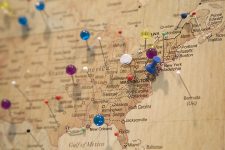The Best Way to Prepare for a Family Emergency
4 min read
Nature Moms –

If a fire or flood affected you tomorrow, would you know what to do? While you don’t want to think about emergencies impacting you and those you love, if you have a family, you must prepare them for the worst.
What are the best ways to prepare for a family emergency? The following eight tips have you covered whether disaster strikes on the road or closer to home.
-
1. Keep Your Cellphone Charged
Cellphones are remarkable devices that let you have a means of contacting others nearly anytime and anywhere. While you will still find dead zones in remote regions like the desert southwest, most areas of the country have coverage — if your device has charge.
Please invest in portable backup chargers and extra cables for you and your family. There are few things more terrifying than frantically trying to reach your kids only to find out later that their phones died. Keep these in their backpacks and your vehicle so that you always have juice handy.
-
2. Check Your Insurance Coverage
You carry homeowners or renters insurance to protect you against fires, hurricanes and other acts of God. However, if you don’t review your policy, you could be stuck with a hefty bill when you already have enough stress.
For example, most standard policies exclude flooding — even if the water damage arises from plumbing issues. Even if your property is at low risk for this disaster, consider taking out coverage for peace of mind. You’ll enjoy lower rates if your property doesn’t fall within a flood plain.
-
3. Practice Your Escape Route
When’s the best time to discover that your 5-year-old is terrified of heights? While experts may disagree, it’s not during a house fire if you have to get them to climb a ladder out of a second-story window.
Walkthrough your home together, identifying all possible escape routes, and practice leaving by various ones. Designate an outdoor meeting location so that you don’t rush back into a burning building after a child who already fled. Do not let your children re-enter for any reason — their life is more important than Fido’s.
-
4. Create a Meetup Point
What if disaster strikes while you are out at work and the kids are at school? The devastating California wildfires illustrate the tragedies that strike when you don’t have a communication system and meetup plan.
Decide on a neutral meeting place to report if a flood or fire strikes when you’re apart. If possible, research your area’s evacuation plan — they may designate a school or other facility to meet and pass out required supplies. If not, choose a location that is within walking or biking distance for kids who don’t yet drive.
-
5. Perform an Annual Home Inspection
If you want to maintain your property’s value, you should immediately remedy any potential hazards. While most homeowners think of annual inspections as a cost-saving measure to fix small problems before they snowball, they can also prevent natural disasters.
If you live in a high-fire risk area, you should keep the landscaping around your home clear. Trim back any tree branches that overhang your roof. Flames can jump to shrubs or start your roof ablaze otherwise.
If your property frequently sees water damage, do what you can to protect your foundation from cracks and walls from mold. A retaining wall, perhaps in conjunction with a rain garden, can keep waters from damaging the structure.
-
6. Carry Basic First Aid
It’s always wise to tuck a basic first aid kit into your purse or briefcase and keep one in your car. You never know when a child might scrape their knee or get a splinter. In an emergency, triage might prohibit health care professionals from quickly tending to minor injuries, but your kids won’t understand the delay.
Stock yours with bandages, a large, clean fabric for making slings, disinfectant wipes and antibacterial ointments, and items like scissors and tweezers. Since 2020 is the year of COVID-19, it’s wise to bring extra masks.
-
7. Prepare a Go-Bag
You don’t want to think about leaving your home behind, but sometimes, emergencies demand evacuation. Take a tip from those who have survived similar events and keep a go-bag at the ready during high-risk periods.
What should you include in your go-bag? Please remember the following:
- A change of clothes and comfortable walking shoes: If you need to abandon your vehicle, you don’t want to be caught in the wilderness in flip-flops.
- Soap, shampoo and other hygiene products: While shelters provide toothpaste and toothbrushes, it can take days or even weeks for supplies to reach affected areas. Make sure you can get reasonably clean without relying on others to help prevent infections.
- A week’s worth of prescription medications: You might not be able to get to your local pharmacy or even reach your doctor. Ask your provider for a travel supply in advance and keep it in your bag.
-
8. Keep Your Car Serviced
Finally, you don’t want to discover that your car won’t start as fires or floodwaters grow closer. Ensure that you have the means to flee by getting your car regularly serviced.
Please get routine oil changes — if you DIY with traditional fluid, do so every 3,000 miles. Synthetic formulations can last anywhere from 5,000 to 15,000 miles but check with your manufacturer on the appropriate mix. Inspect all hoses and belts and kick your tires. If your check engine light comes on, take your vehicle for service.
-
Prepare for Family Emergencies With These Eight Tips
You don’t want to imagine the unthinkable, but disasters like fires and hurricanes occur. Prepare your family for emergencies with the eight wise tips above.
The post The Best Way to Prepare for a Family Emergency appeared first on Nature Moms.
(c) Nature Moms – Read entire story here.






